Abstract
U.S. health care costs are disproportionately concentrated among older adults with multiple chronic conditions or functional limitations—a population often referred to as “high-need” patients. This analysis uses data from the Commonwealth Fund 2014 International Health Policy Survey of Older Adults to investigate health care use, quality, and experiences among high-need patients in nine countries compared with other older adults. High-need patients use a greater amount of health care services and also experience more coordination problems and financial barriers to care compared with other older adults. Disparities are particularly pronounced in the United States. The comparative success of other countries, particularly in reducing financial barriers to care, may be a product of policies that specifically target high-need patients. Similarly focusing on these populations in the U.S. and effectively managing their care may improve their health status while reducing overall costs.
INTRODUCTION
A large portion of U.S. health care spending goes to the care of high-need patients. These individuals—people with clinically complex conditions, cognitive or physical limitations, or behavioral health problems—use a disproportionate amount of health care services and therefore represent an outsized percentage of costs. Five percent of the U.S. adult population accounts for 50 percent of the nation’s health care costs and 10 percent accounts for 65 percent of total costs.1 The top 10 percent of spenders age 18 and older accrue health care expenditures of at least $12,000 per person per year, compared with a nationwide median of $1,100.2 Focusing on these high-need patients can go a long way toward containing costs while helping people lead healthier lives.
This analysis builds on an earlier Commonwealth Fund survey that focused on adults age 55 and older and their health care experiences in 11 high-income countries.3 In this brief, we describe the subset of high-need adults ages 65 and older in nine of these countries (Australia, Canada, France, Germany, the Netherlands, Norway, Sweden, Switzerland, and the United States) and then compare their patterns of health care use, financial barriers to care, care coordination, and their doctor–patient relationships to those of other older adults. We highlight important aspects that may play a role in reducing costly utilization for this population, and which should factor into the development of any policy solutions. We also highlight policies in countries that have had success in providing care for this population, drawing insight for the U.S. and other countries.
SURVEY FINDINGS IN DETAIL
Who Are High-Need Patients?
In this brief, “high-need” patients are defined as those age 65 and older with at least three chronic conditions or a functional limitation in activities of daily living, like dressing or bathing. (See Methods.) Among the countries surveyed, the U.S. had the highest percentage of older adults with three or more chronic conditions (42%) (Exhibit 1). Prior studies have shown that having difficulty with activities of daily living—even when people do not have accompanying chronic conditions—can hinder people from getting needed, appropriate care.4 Older adults in Australia and the U.S. reported functional limitations at lower rates (14%) than their counterparts did in the other countries surveyed (Exhibit 2).
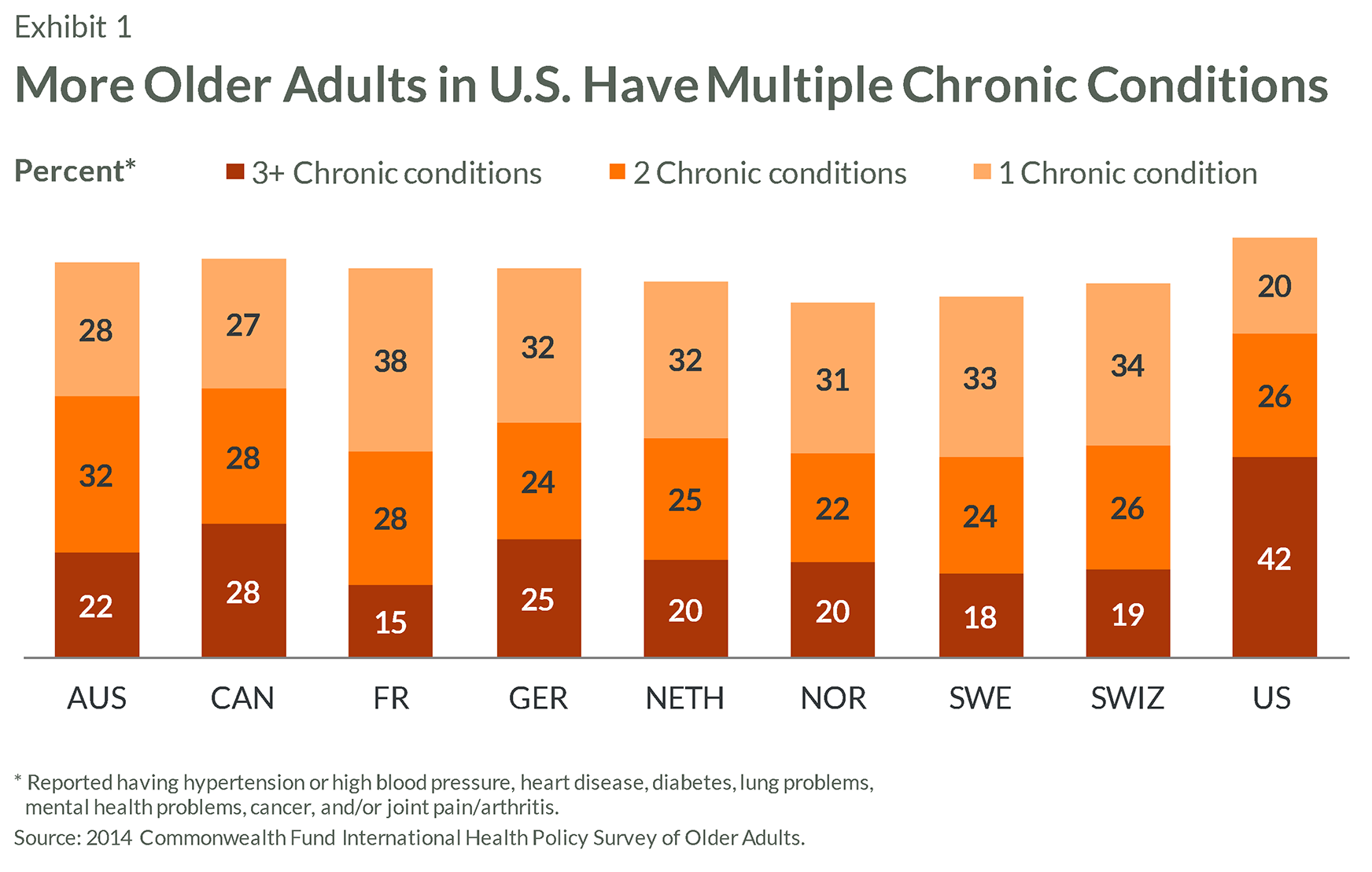
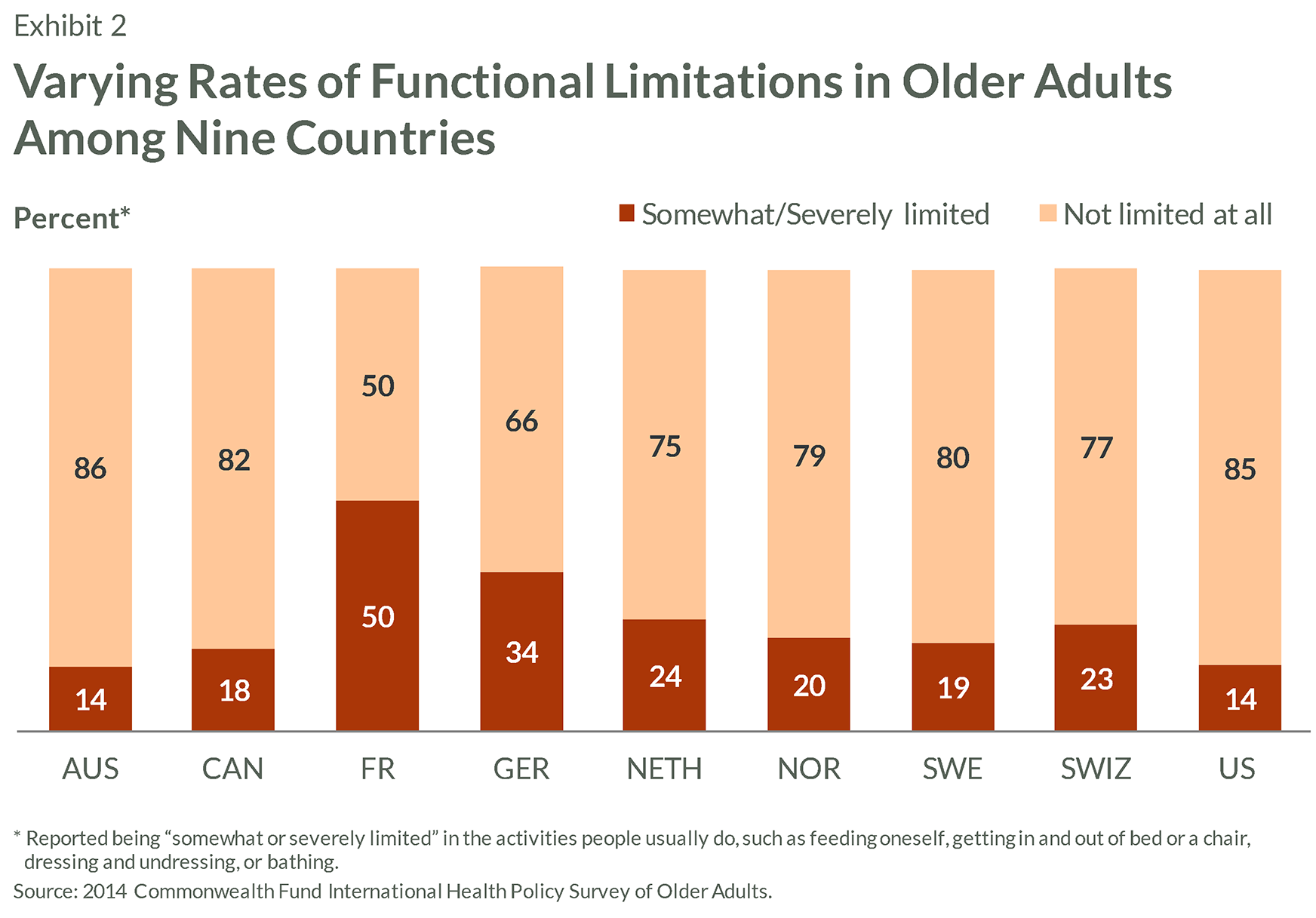
In most countries, including the U.S., high-need older people tend to have low incomes, adding to their vulnerability and the need for protective policies (Appendix Table 1).
High-Need Adults Use More Health Care
As expected, across all countries, high-need patients use more health care compared with other older adults (Appendix Table 2). High-need patients were more likely to have seen four or more doctors in the past year, more likely to regularly take four or more prescription drugs, more likely to have been hospitalized overnight, and more likely to have visited the emergency department (ED) multiple times in the past two years. Higher utilization was especially pronounced in the U.S., where high-need patients use services at double to triple the rates for other older adults in all but one measure.
In the U.S. and four other countries (Canada, France, Sweden, and Switzerland), high-need patients' use of the ED in the past two years for a condition that could have been treated by their regular doctor was significantly greater compared with other older adults. In the U.S. and Canada, about one of five (19%) high-need patients reported an avoidable ED visit. The disparity between high-need and other adults was the greatest in the U.S. (Exhibit 3).
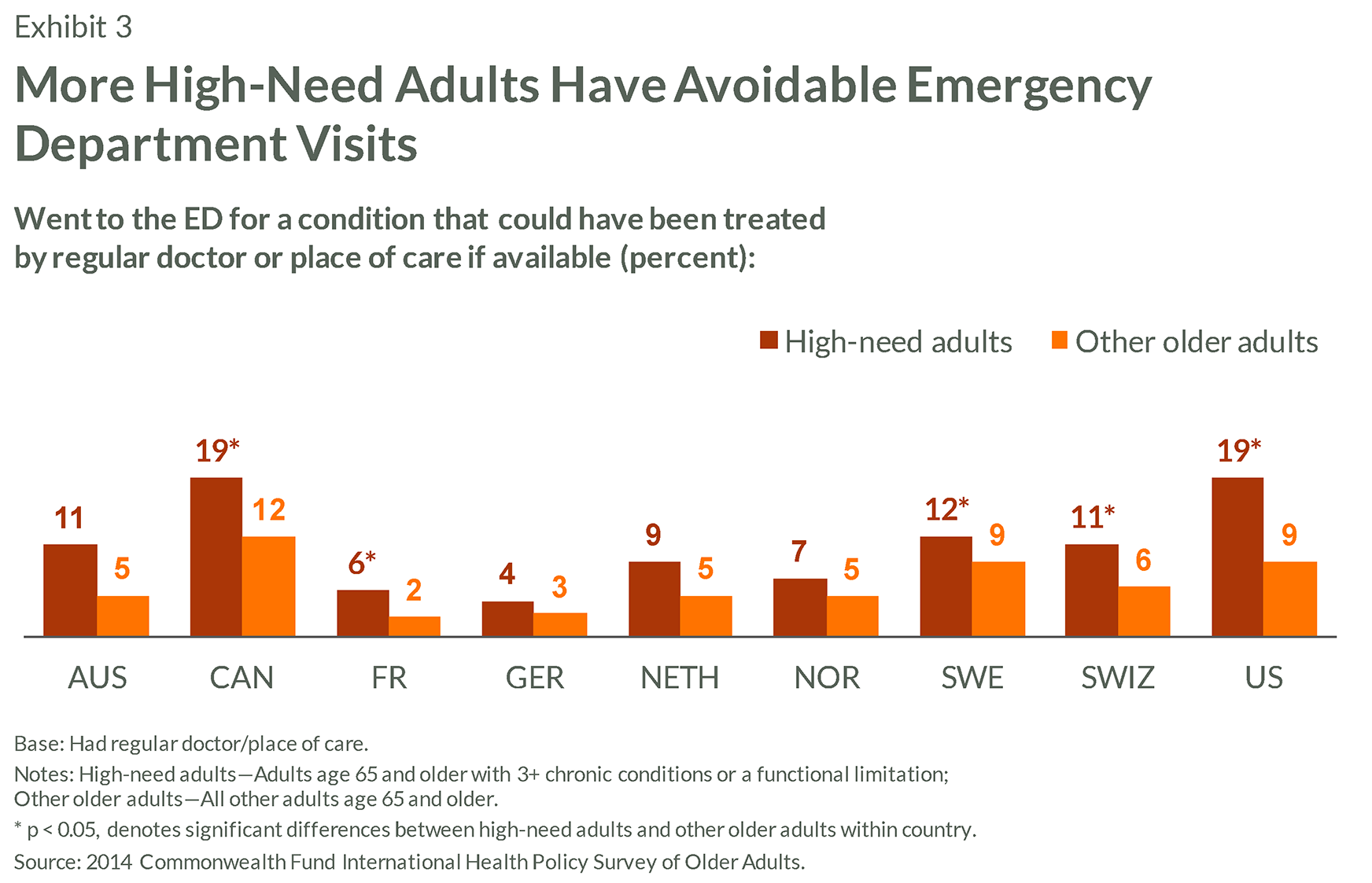
High-Need Adults Experience Cost-Related Barriers to Care
More high-need adults faced cost-related problems accessing needed care as well (Exhibit 4). These problems included having a medical problem but not visiting the doctor; skipping recommended tests, treatment, or follow-up because of cost; or skipping or not filling prescriptions because of cost. More than one of five (22%) high-need adults in the U.S. reported such a problem—the highest rate of any of the countries studied. Even U.S. adults who were not considered high-need experienced cost-related access problems at a greater rate than high-need adults in seven of the eight other countries surveyed.
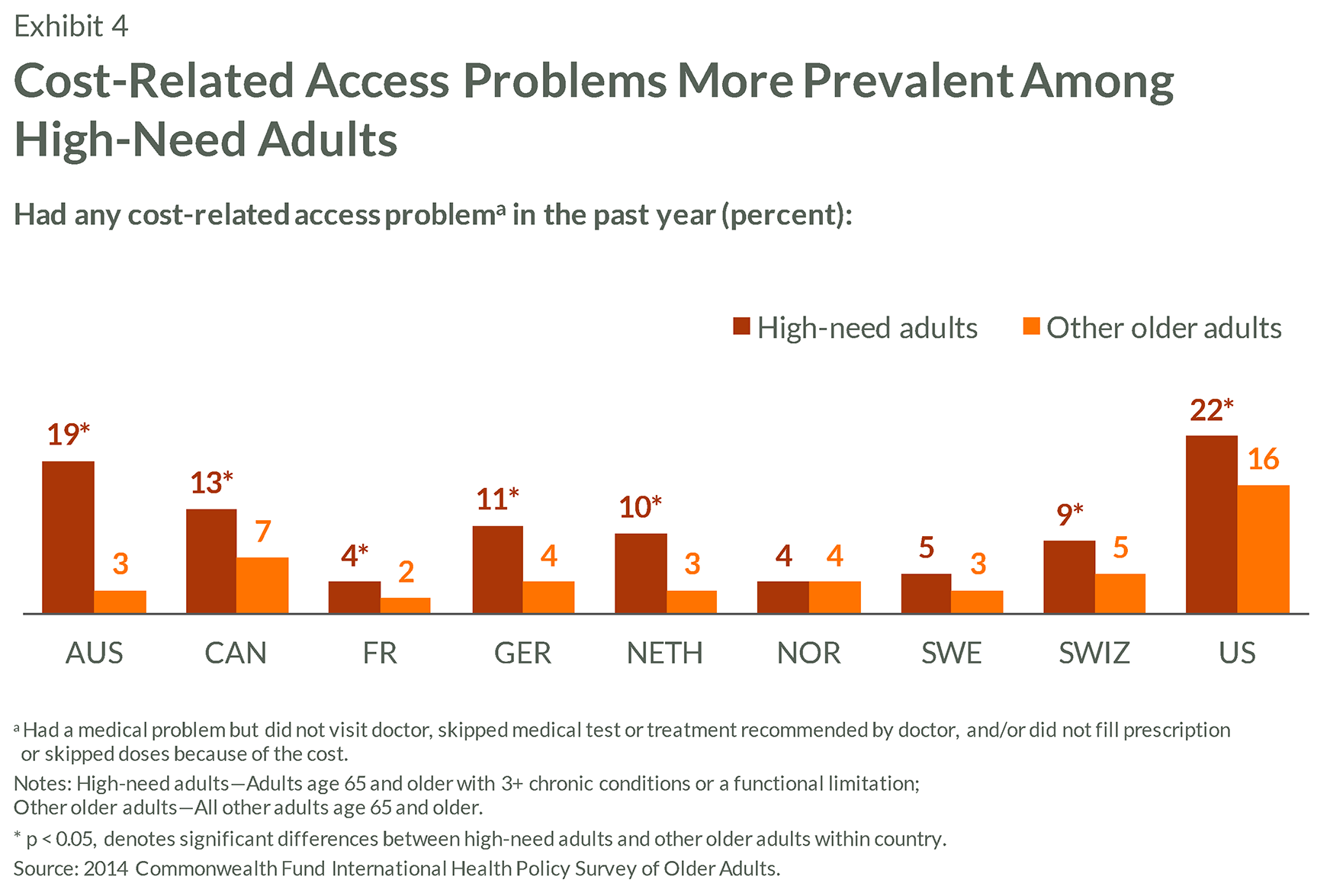
Care Coordination Often Disjointed for High-Need Adults
The high-need population is especially susceptible to problems of poor coordination within the health system. At least one of four high-need adults in nearly all the countries studied experienced a coordination problem (Exhibit 5). In Germany, Norway, and the U.S., nearly half of high-need adults had such a problem. High-need patients in the U.S. reported the following at much higher rates than did other older adults: test results were not ready at the time of appointment or duplicate tests were ordered (29% high-need vs. 17% others); patients received conflicting information from doctors (20% vs. 13%); and specialists lacked information or their regular doctor was not informed about the specialist care received (23% vs. 13%) (Appendix Table 3).
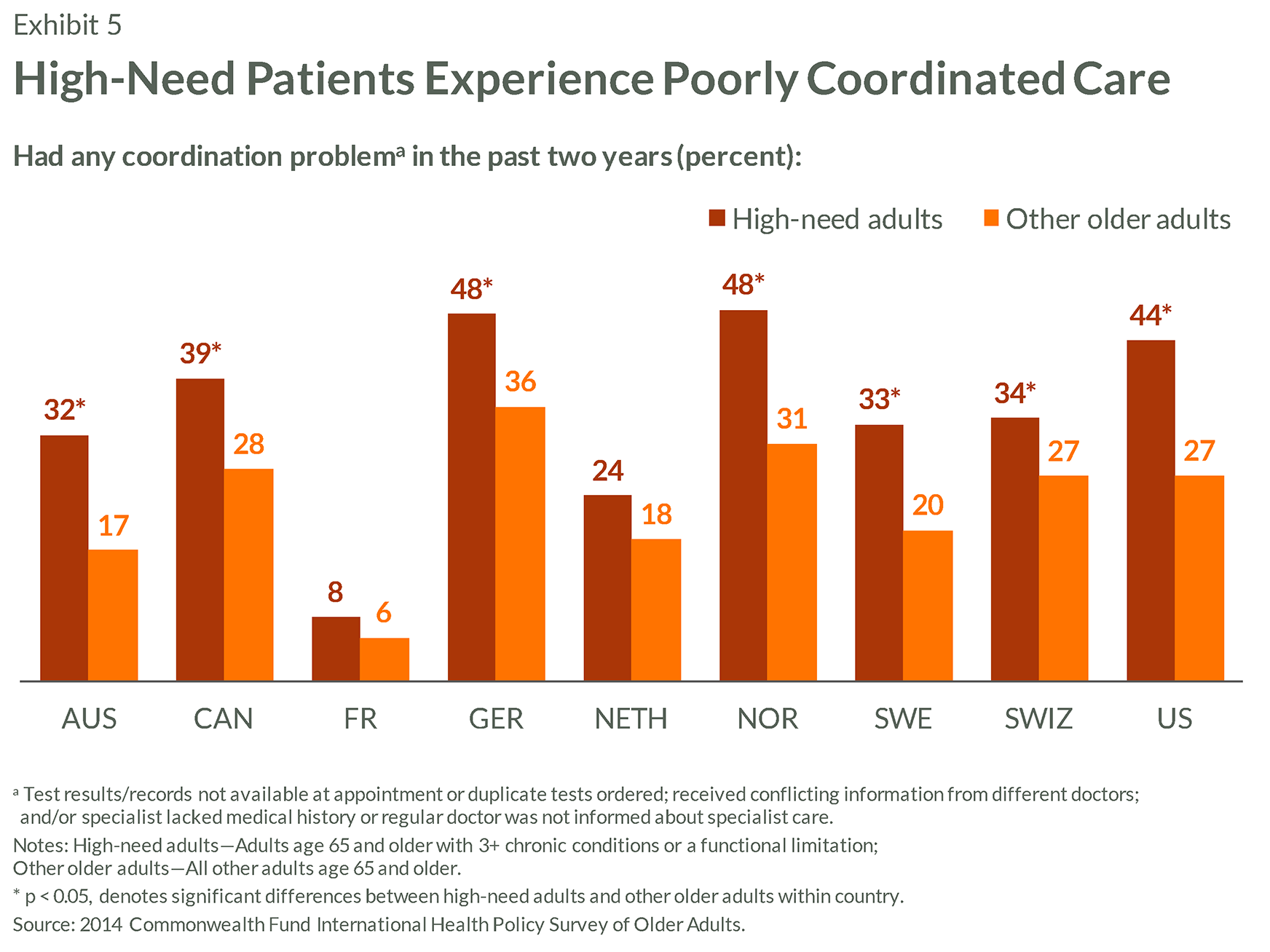
High-need patients seeing multiple providers and taking multiple medications are at higher risk of experiencing costly medical errors.5 Almost across the board, more high-need adults reported they thought a medical mistake was made in their treatment or care compared with other older adults with at least one chronic condition (Exhibit 6). In the U.S., more than twice as many high-need adults (13%) reported these mistakes as other older adults (6%). This discrepancy was most pronounced in Switzerland, where four times as many high-need adults (17%) believed they experienced a medical error compared with other older adults (4%).
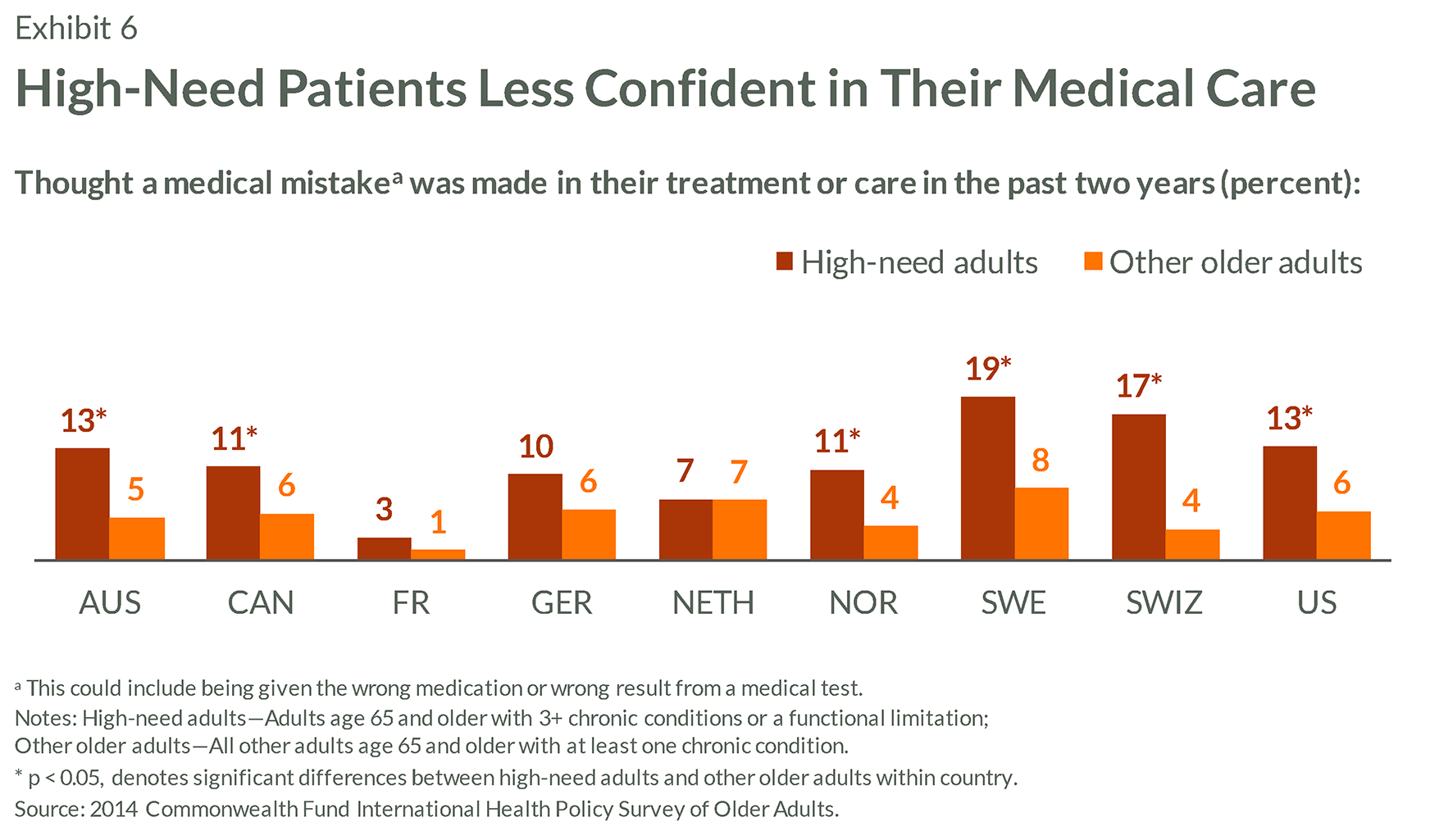
In U.S., Providers More Engaged in Patients' Care
High-need patients were more likely than other patients with at least one chronic condition to report that a health care professional contacted them between visits to see how they were doing. In the U.S., 37 percent of high-need adults reported that someone contacted them between doctor visits, compared with 23 percent of other older adults with at least one chronic condition (Exhibit 7).6 These discrepancies were similar across all other countries, but the overall rates for both populations—all of whom have at least one chronic condition—are low.
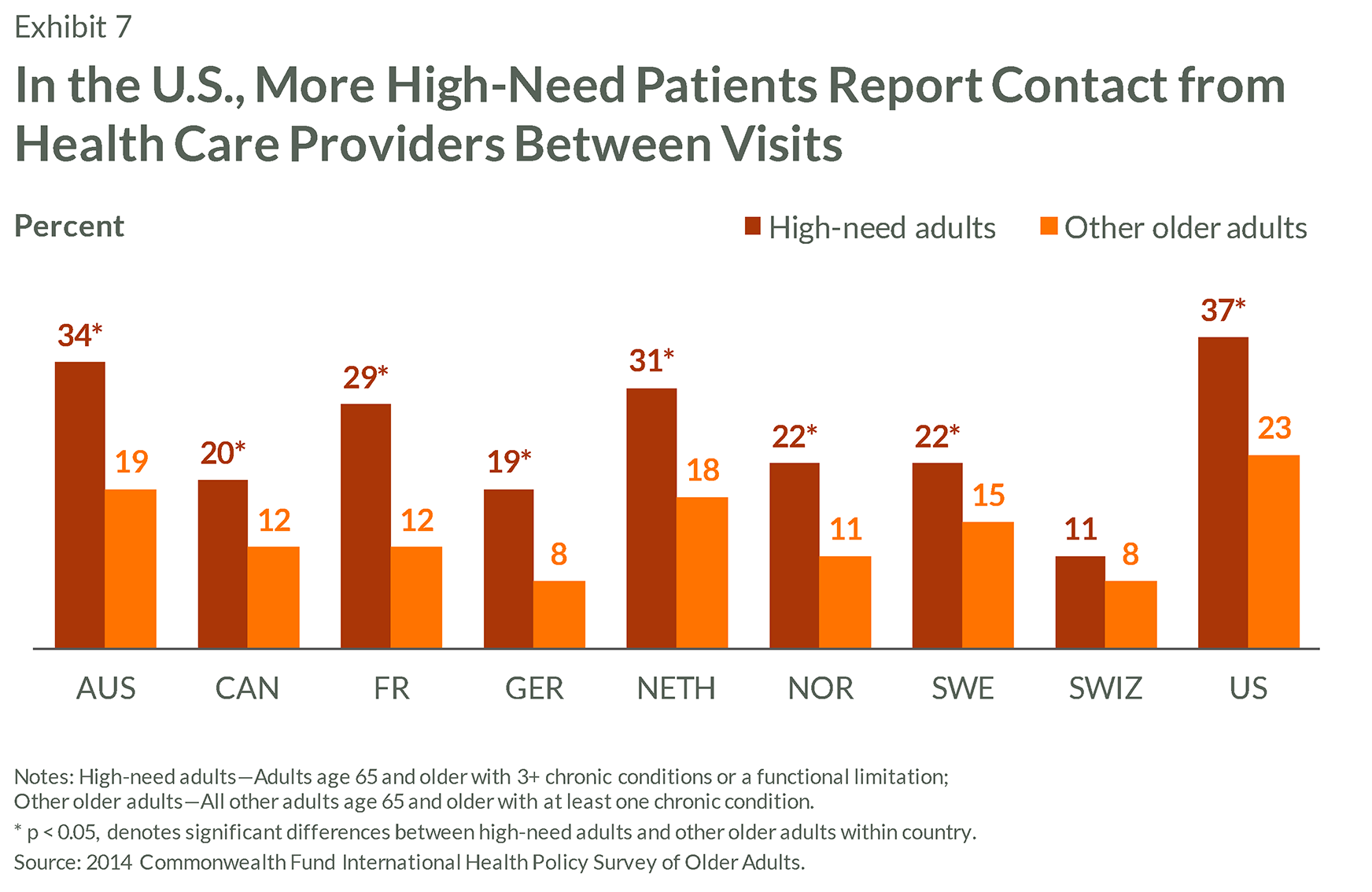
Though high-need patients experience many barriers to receiving high-quality care, they are very likely to have a treatment plan, especially in the U.S.7 Nearly nine of 10 (87%) high-need adults in the U.S. reported they had a daily treatment plan. The U.S. rates were highest among the countries surveyed (Exhibit 8).
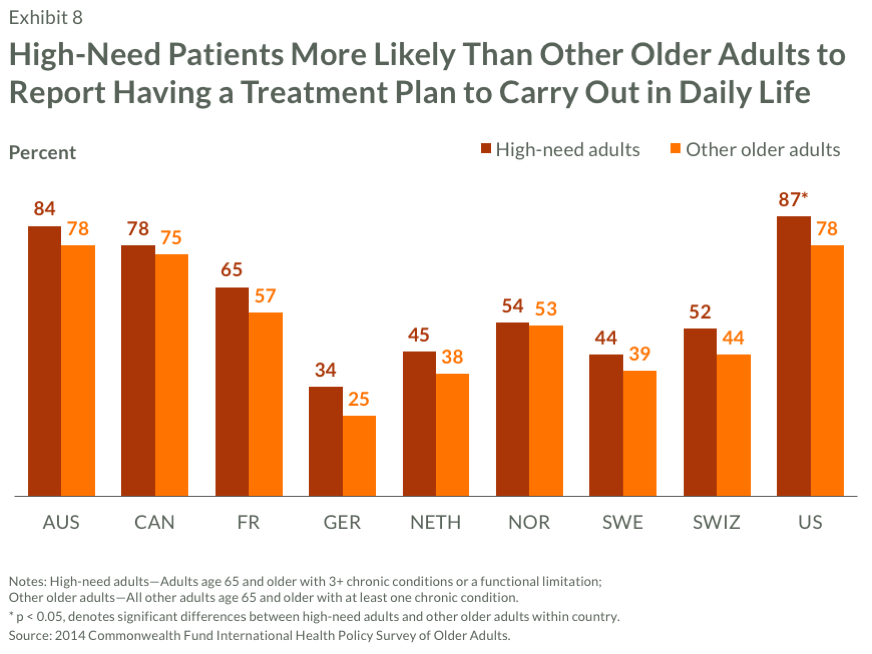
DISCUSSION
Across all countries surveyed, high-need patients had higher rates of health care utilization compared with other older adults, with the greatest differences between populations seen in the U.S. While performance for high-need patients typically mirrors performance for patients overall, there are some differences. For instance, the U.S. underperforms the other countries studied in avoidable ED use and cost-related access problems for all older adults. For high-need patients, performance on these measures is significantly worse. For care coordination and perceived medical mistakes, the U.S. falls in the middle, though there are distinct disparities between the experiences of high-need patients and those of other older adults. The U.S. outperforms the other countries in contacting patients between visits and providing treatment plans, particularly for high-need patients.
Poor performance for high-need patients may contribute to high costs. By using ED visits instead of primary care (when such care is inaccessible), these patients inadvertently increase health care spending and further fragment their own care. In addition, lack of care coordination may lead to overuse of care, particularly in lab tests and imaging.8 Research also has shown that less-engaged patients cost more than highly engaged patients. Encouraging physicians to get patients involved in their care may further help reduce cost growth.9
Health systems that tend to perform well specifically with regard to high-need patients share common markers of high performance in other areas as well. Data from the Commonwealth Fund 2015 International Health Policy Survey of Primary Care Physicians in 10 Countries indicate that these countries tended to have a higher percentage of physician practices that have after-hours arrangements for patients (Germany, the Netherlands, Norway), frequently make home visits (the Netherlands, France, Germany), and use nurse case managers for people with serious chronic conditions (France, the Netherlands, Sweden).10
Success in other countries, particularly in reducing financial barriers to care, may be the result of policies that target high-need patients. France, for instance, has eliminated copayments for individuals with any of 32 chronic illnesses—essentially eliminating any cost-related barriers to care for this population.11 Germany’s disease management programs for chronically ill patients combine technology, quality assurance (e.g., reminders and benchmarking), and financial incentives for physicians, patients, and payers. Since the implementation of these programs, hospitalization rates, duration of hospital stay, mortality, and drug costs have decreased while quality of care and patient satisfaction have improved.12 Further analysis of these policies and their key features can help U.S. policymakers provide better care to high-need patients.
Full appendices available here.
Notes
1 S. B. Cohen and W. Yu, The Concentration and Persistence in the Level of Health Expenditures over Time: Estimates for the U.S. Population, 2008–2009, Statistical Brief #354 (Rockville, Md.: Agency for Healthcare Research and Quality, Jan. 2012).
2 E. T. Roberts and G. Anderson, Johns Hopkins University, “High Cost and High Need Patients: An Analysis Using the 2009–2011 Medical Expenditure Panel Survey-Household Component,” Presentation to The Commonwealth Fund, Oct. 2014.
3 R. Osborn, D. Moulds, D. Squires, M. M. Doty, and C. Anderson, “International Survey of Older Adults Finds Shortcomings in Access, Coordination, and Patient-Centered Care,” Health Affairs Web First, published online Nov. 19, 2014.
4 G. Anderson and J. R. Knickman, “Changing the Chronic Care System to Meet People’s Needs,” Health Affairs, Nov./Dec. 2001 20(6):146–60.
5 Institute of Medicine, To Err Is Human: Building a Safer Health System (Washington, D.C.: National Academies Press, 2000).
6 This battery of questions was only asked of respondents with at least one chronic illness. Therefore, the comparison category for Exhibits 7 and 8 is all other adults over age 65 and with at least one chronic condition.
7 The term "treatment plan" should be interpreted with caution; respondents were asked "Do you have a treatment plan for your __________ [chronic disease] that you can carry out in your daily life?” Without providing a technical definition for "treatment plan" in the survey, this term was open to interpretation by the respondents, and could have different meanings across countries.
8 D. M. Berwick and A. D. Hackbarth, “Eliminating Waste in U.S. Health Care,” Journal of the American Medical Association, April 11, 2012 307(14):1513–16.
9 J. H. Hibbard, J. Greene, and V. Overton, “Patients with Lower Activation Associated with Higher Costs; Delivery Systems Should Know Their Patients’ ‘Scores’,” Health Affairs, Feb. 2013 32(2):216–22.
10 Commonwealth Fund 2015 International Health Policy Survey of Primary Care Physicians in 10 Countries. Findings from the 2015 survey were reported in the following journal article: R. Osborn, D. Moulds, E. C. Schneider, M. M. Doty, D. Squires, and D. O. Sarnak, “Primary Care Physicians in Ten Countries Report Challenges in Caring for Patients with Complex Health Needs,” Health Affairs, Dec. 2015 34(12):2104–12. Countries cited in parentheses reflect the top three performers for each measure as defined by the highest percentage of primary care physicians reporting “yes.”
11 E. Mossialos, M. Wenzl, R. Osborn, and C. Anderson, International Profiles of Health Care Systems, 2014 (New York: The Commonwealth Fund, Jan. 2015).
12 S. Stock, D. Starke, L. Altenhofen et al., Disease Management Programs Can Improve Quality of Care for the Chronically Ill, Even in a Weak Primary Care System: A Case Study from Germany (New York: The Commonwealth Fund, Nov. 2011); M. Schunk, B. Schweikert, O. Gapp et al., “Time Trends in Type 2 Diabetes Patients’ Disease Management and Outcomes: Evidence from Two KORA Surveys in Germany,” Experimental and Clinical Endocrinology and Diabetes, Feb. 2009 117(2):88–94; T. Elkeles, W. Kirschner, C. Graf et al., “Health Care In and Outside a DMP for Type 2 Diabetes Mellitus in Germany—Results of an Insurance Customer Survey Focusing on Differences in General Education Status,” Journal of Public Health, June 2009 17(3):205–16; A. Tuffs, “Diabetic Patients in Chronic Disease Management Programmes Live Longer,” BMJ, 2008 337:a1348; and D. Ose, M. Wensing, J. Szecsenyi et al., “Impact of Primary Care-Based Disease Management on the Health-Related Quality of Life in Patients with Type 2 Diabetes and Comorbidity,” Diabetes Care, Sept. 2009 32(9):1594–96.
|
The Commonwealth Fund 2014 International Health Policy Surveya was conducted by SSRS from March through May 2014. The survey consisted of computer-assisted telephone interviews of nationally representative random samples of adults age 55 or older in 11 countries using a common questionnaire that was translated and adjusted for country-specific wording as needed. The survey explored older adults’ experiences with their health care system. Final samples were weighted to reflect the demographic characteristics of older adults in each country. “High-need” was defined as having three or more chronic conditionsb or a functional limitation. A functional limitation was defined as being somewhat or severely limited in activities that people usually do, such as feeding oneself, getting in/out of bed or a chair, dressing/undressing, or bathing. This analysis was limited to adults age 65 or older to ensure continuity of insurance status between countries. Final country samples, shown in Table 1, ranged from 597 to 4,808. (Two countries from the original survey, New Zealand and the United Kingdom, were excluded from this analysis because of limited sample sizes.) Logistic regressions were estimated to test for significant differences between high-need patients and other older adults within each country (data not shown). A technical description of the analytic methods is available from the authors upon request. There are two main limitations of the analysis in this brief. First, while we refer to the cost implications of this population, this particular data set is not linked with claims data, and we can only assume costs are higher because of higher utilization rates. Second, the construction of the high-need variable is based on self-reported data of having chronic conditions, as well as functional limitations, and thus should be interpreted with caution in the international context. Regarding the high rate of functional limitations in the French sample, French respondents were not more likely to have been diagnosed with a chronic condition, or to describe their status as “fair” or “poor.” We have come to believe that the French functional limitation responses may reflect the subjective nature of the question. Respondents were asked, “To what extent are you limited in the activities people usually do, such as feeding yourself, getting in and out of bed or a chair, dressing and undressing, or bathing?”
As shown in the above table, France was only an outlier on the number of respondents reporting “somewhat limited,” and not “severely limited.” It is possible that the response category “somewhat limited,” when translated in to French, may have been interpreted differently. We note that French-speaking Swiss respondents were more likely than other Swiss respondents to say they were “somewhat or severely limited” (28% compared with 21%), as were French-speaking Canadians (25% compared with 16%). aCommonwealth Fund 2014 International Health Policy Survey of Older Adults in 11 Countries. Findings from the 2014 survey were reported in the following journal article: R. Osborn, D. Moulds, D. Squires, M. M. Doty, and C. Anderson, “International Survey of Older Adults Finds Shortcomings in Access, Coordination, and Patient-Centered Care,” Health Affairs Web First, published online Nov. 19, 2014. |
